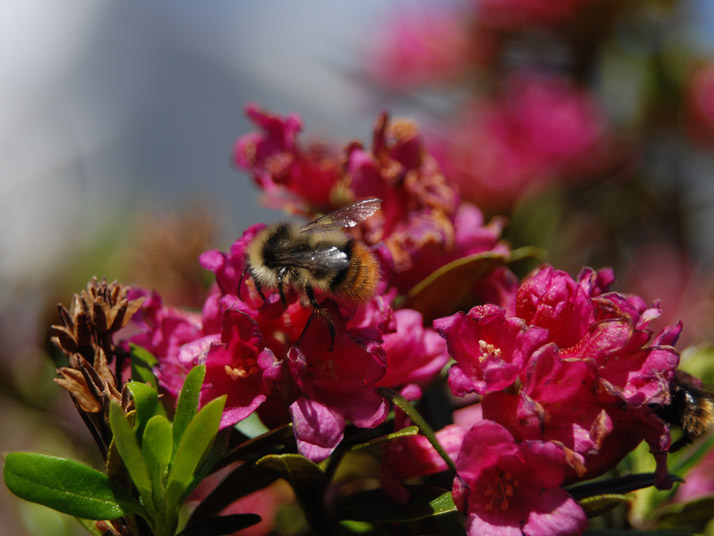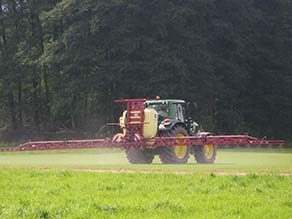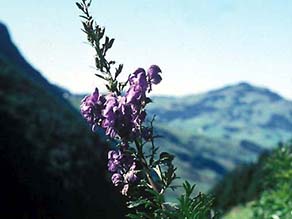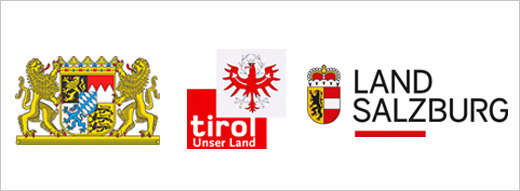Alps, persistent pollutants and insects

In the protectAlps project, the LfU, together with German and Austrian project partners, investigated the harmful effects of chemical stressors on insects in the Alpine region. Standards and framework conditions were created for a joint, cross-border approach to the protection of alpine biodiversity.
 Flowers at high altitudes of the Alps show the important role of pollinating insects; Picture: Nationalpark Berchtesgaden
Flowers at high altitudes of the Alps show the important role of pollinating insects; Picture: Nationalpark BerchtesgadenBackground: insects and chemical stressors
The abundance of insects has declined strongly in recent years. There are various causes for the decline in number of insect species and biomass, including the intensification of agriculture and the use of fertilizers and pesticides. A possible reason for a decline, also in areas far from agricultural areas, are ubiquitous pollutants. Especially, hardly degradable, chemical pollutants which undergo long-range transport are possible factors which influence the abundance of insects. These pollutants are called persistent organic pollutants (POP).
POPs include certain internationally regulated pesticides such as DDT and industrial chemicals such as brominated flame retardants. These chemical stressors can accumulate in the organism of insects and are considered toxic. Heavy metals such as mercury (Hg) behave similarly in the environment. Together with POPs, these pollutants are referred to as persistent, bioaccumulative and toxic chemicals (PBTs). The project was the first to collect unique data on the exposure of insects in the Alpine region to PBTs.
Although the Alps are generally far away from industrial areas, they are also affected because of condensation effects, which increase the entry of these pollutants in cold areas with high precipitations rates. This means, that the alpine ecosystems are polluted even at lower air concentrations.
In addition to persistent organic pollutants, which are able to affect the insects directly, the input of nitrogen changes the composition of plant communities. This has an indirect impact on the occurrence of insects in alpine regions. Nitrogen compounds are emitted from traffic and agriculture and are transported via the atmosphere.
 Insects play an important role for the entire ecosystem
Insects play an important role for the entire ecosystem  Certain plant protection products as well as nitrogen from traffic and agriculture are suspected to have a negative influence on insects even in alpine regions Foto: Erwin Attenberger
Certain plant protection products as well as nitrogen from traffic and agriculture are suspected to have a negative influence on insects even in alpine regions Foto: Erwin AttenbergerObservation of chemicals in the Alps
Measurements of air concentrations and inputs of persistent pollutants in the Alps served as baseline for protectAlps.
 The Schneefernerhaus Environmental Research Station on the Zugspitze mountain; Picture: © M.Neumann UFS GmbH
The Schneefernerhaus Environmental Research Station on the Zugspitze mountain; Picture: © M.Neumann UFS GmbHThe measurements of the ambient air concentrations are carried out since 2005 on Zugspitze mountain in Bavaria and Hoher Sonnblick mountain in the national park Hohe Tauern in Austria (Environmental Research Station Schneefernerhaus, UFS and Sonnblick Observatory, SBO).
For an exact comparison of the measured values, the methods on the Bavarian and Austrian side have been coordinated since the project MONARPOP (2005). For mountains in mid-latitudes, these series of measurements are unique.
Direct effects of chemicals on insects
In order to get information about the influence on the insects, suitable target species on both sides of the border were defined. Bumblebees, ants and burying beetles were selected to cover herbivorous animals as well as omnivores and scavengers. The selection provides an insight into the accumulation of pollutants via the food chain. The selected insects were caught in campaigns during the summer months of 2019 and 2020 and analysed for persistent pollutants in ultra-trace laboratories.
At the University of Innsbruck, irregularities in the morphology of insects were investigated by measuring characteristic structures for example the wings. Differences between actually symmetrical parts of the body are regarded as an indication of influence on the animals due to stressors. By default, at the University of Innsbruck genetic causes of asymmetries in the body parts are investigated. It may be caused by inbreeding in populations with only a few individuals.
Genetic causes for asymmetries in the insects, examined during the project, could be excluded. A wide range of PBT substances were detected in the sampled insects and indicate an accumulation via the food chain. In particular, the concentrations of mercury, PCBs and polybrominated flame retardants correlated with deformations in the body structure of the insects. A direct effect of these chemicals on insects, in concentrations such as those measured in the alpine ecosystem on the Zugspitze, can be assumed to be very likely.
Concentration ranges of the substances that correlated with asymmetries (based on fresh weight):
| Substances | Bumble bees (Bombus pratorum, B. wurflenii) | Ants (Formica exsecta, F. aquilonia) | Burying beetles (Nicrophorus vespilloides) |
|---|---|---|---|
| Quecksilber | 0,65 - 8,81 µg/Kg | 5,3 – 27 µg/Kg | 45 – 97 µg/Kg |
| Polychlorierte Biphenyle (PCB) | 0,067 – 0,22 µg/Kg | 0,16 – 1,1 µg/Kg | 0,14 – 12 µg/Kg |
| Polybromierte Diphenylether (PBDE) | 0,0049 – 0,86 µg/Kg | 0,0067 – 1,2 µg/Kg | 0,0039 – 0,56 µg/Kg |
In addition to the substances mentioned above, PFAS were also detected in ants and burying beetles (PFHxA, PFNA, PFHpA, PFOA, PFOS). Furthermore, organochlorine pesticides were detected in burying beetles (cis-heptachlor epoxide and endrin).
 By measuring characteristic structures, the exposure of insects to chemicals can be compared with deformations in their body structure; Foto: Nils Struck
By measuring characteristic structures, the exposure of insects to chemicals can be compared with deformations in their body structure; Foto: Nils Struck
Indirect effects of nitrogen
Nitrogen plays a central role in the nutrient supply of plants. In the course of their evolution, many plants have adapted to a lack of plant-available nitrogen compounds. However, with nitrogen releases from road traffic and agriculture, humans are massively intervening in the nitrogen cycle. The result is that even in remote areas more nitrogen gets available for plants. As a result, the plant communities are changing towards species for which higher nitrogen contents are particularly favorable.
 The genus Aconitum is one of the plant genera that are essential for an insect species. Only where Aconitum occurs the Aconitum-bumblebee (Bombus gerstaeckeri) can exist; Photo Dr. Walter Joswig
The genus Aconitum is one of the plant genera that are essential for an insect species. Only where Aconitum occurs the Aconitum-bumblebee (Bombus gerstaeckeri) can exist; Photo Dr. Walter JoswigThe insects are indirectly affected by the nitrogen inputs, because many species of insects are specialized in a few plant species.
Long time- series of measurements in remote areas are necessary to measure long-term trends in the input of nitrogen compounds from air.
As part of the protectAlps project, the measurement of nitrogen input was matched with data from vegetation mapping. This provides a data basis for estimating the indirect effects of nitrogen input on insects in the future.
Project partners
On bavarian side, Bavarian Environment Agency (LfU) and the Environmental Research Station Schneefernerhaus on the Zugspitze mountain were involved in the project. Project partners from Austria are the Leopold-Franzens-University of Innsbruck with the Institute for Ecology (Prof. Birgit Schlick-Steiner and Assoc.-Prof. Florian Steiner) from Tyrol as well as the Sonnblick Observatory Hoher Sonnblick in Salzburger Land.

Funding
The project was funded by the European Union within the INTERREG A program under the title "Project for the valuation of chemical stressors for the protection of alpine biodiversity with a focus on insects" and the project number AB173.
The project was cofinanced by the Bavarian State Ministry for Environment and Costumer Protection (StMUV) and the ZAMG (Austria).
Contact
If you are interested in the project, please contact:
Bavarian Environment Agency, Evaluation of Substances and Chemicals
- Veronika Hierlmeier-Hackl, Tel.: +49-(0)-821/9071-2905
- Dr. Korbinian Freier, Tel.: +49-(0)-0881 93541-1118
Publications in English from the project
- Hierlmeier et al.: Persistent, Bioaccumulative, and Toxic Chemicals in Wild Alpine Insects: A Methodological Case Study. In: Environmental Toxicology and Chemistry, Volume 41, Issue 5, 2022, 1215–1227.
- Hierlmeier et al.: Persistent, bioaccumulative, and toxic chemicals in insects: Current state of research and where to from here? In: Science of The Total Environment, Volume 825, 2022, 153830.
Further information
Links
- Funding programm INTERREG
- Project partner Schneefernerhaus on the Zugspitze mountain
- Project partner Sonnblick Observatory
- Projektpartner Leopold-Franzens-University of Innsbruck- Molecular Ecology
- Pressrelease of the Bavarian State Ministry for Environment and Consumer Protection
- Project PureAlps – Monitoring of Persistent Organic Pollutants in the Alps

